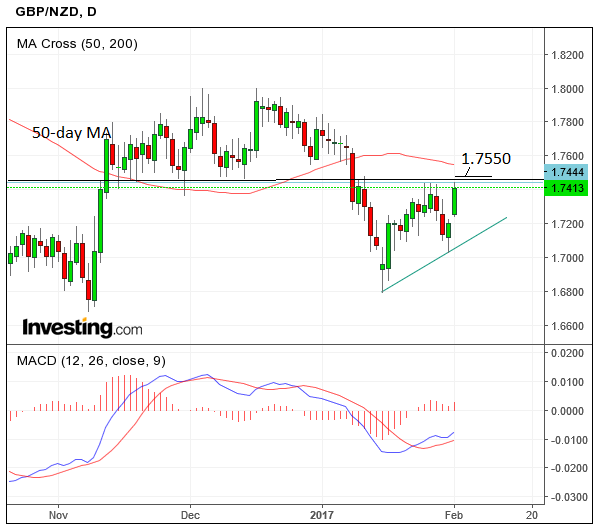New Zealand Dollar Predicted to Lose Further Ground Against Pound Near-Term as Job's Blip Weighs

The Pound gapped higher against the New Zealand Dollar on Wednesday largely thanks to the decent GBP rally we saw at the start of the month - Sterling was the best performer in the G10 group for the day.
But, the move also has NZD weakness to thank.
"The NZ Dollar fell sharply yesterday after the Unemployment rate jumped higher as the recent surge in migration meant there were more workers chasing fewer jobs. The migration boom has been so strong that average hourly earnings actually fell during the quarter. The news will put the Reserve Bank back on the side-lines and ensure there will be no rate hikes until well into 2018," says a note from HiFX Limited.
The move higher in GBP/NZD reinforces the pairs short-term uptrend which we believe is poised to break higher, above resistance at the 1.7437 highs.
Any resultant move above the 1.7450 level in GBP/NZD would probably confirm a break higher to a target at 1.7550 - this is the level of the 50-day moving average (MAV).
The 50 MAV is not just a useful indicator for gauging the trend but also acts as a dynamic area of support and resistance.
It is thus expected that the exchange rate will be repulsed if it touches the MAV or at least that it will encounter some strong selling activity which will slow its rise.
Jobs Data Weighs, But Could be Temporary
As mentioned, part of the reason for the Pound’s recovery versus the Kiwi was surprisingly poor New Zealand jobs data released on Tuesday, January 31.
This showed the New Zealand Unemployment Rate in Q4 rise to 5.2% from 4.9% previously when it had been expected to fall to 4.8% - not rise.
Average Hourly Earnings in New Zealand were considered more important by analysts as they are more sensitive to tightening in the labour market and inflationary pressures.
These rose in Q4 to 29.84 from 29.67 previously, which may have offset some of the negativity.
However, there is the prospect 2017 will be a good year for wages.
The ANZ's Job Ads report, released on January 2, shows that the New Zealand labour market remains robust and will likely remain so through 2017.
ANZ job advertising fell 0.2% in January (seasonally adjusted), its first fall in 17 months but on a rolling 3-month average basis, job ads are up 19.6% from a year ago, the strongest growth in more than five years.
Auckland is the strongest of the main centres, with job ads 21.5% higher than a year ago (+6.1% 3m/3m).
Wellington job ads are flattening (+2.3% 3m/3m, +15.1% y/y).
Canterbury job ads reflect that the rebuild effort continues to slow (-0.5% 3m/3m, +0.7% y/y) (all 3m average).
"Our largest cities continue to be outdone by the regions. All but one of the 11 less-urbanised regions are recording annual job ad growth stronger than any of the three main centres," says Sharon Zollner, Senior Economist at ANZ Bank in Aukland.
Despite a lift in the unemployment rate in the December quarter due to strong labour supply growth, ANZ argue it seems clear that labour shortages exist around the country.
"We expect wage growth to lift this year," says Zollner.
If correct, this should aid the NZD going forward.
In addition, recent inflation data was stronger-than-expected and led to a bump higher for the Kiwi.
Nevertheless, interest rate expectations are fairly neutral in the year ahead according to a recent report by Westpac Bank who see little chances of a pro-NZD interest rate rise at the RBNZ.
Nevertheless, Westpac maintain an overall bullish outlook for the currency against the Pound, notwithstanding risks of a rebound for Sterling from a hawkish BOE meeting.
Sterling Takes Centre Stage on Thursday
On Thursday, the Pound steals the spotlight as the Bank of England (BOE) update markets on their latest policy stance.
It is possible that Sterling could appreciate towards the end of the week due to the BOE upgrading their forecasts for growth and inflation.
Recent positive data showing strong consumption and a tightening labour market could lead the BOE to thinking it has more room to tackle rising inflation.
This could lead to heightened expectations of the BOE raising interest rates, and Thursday is likely to show, at the very least, a change of stance from neutral to hawkish, which would propel Sterling higher.






